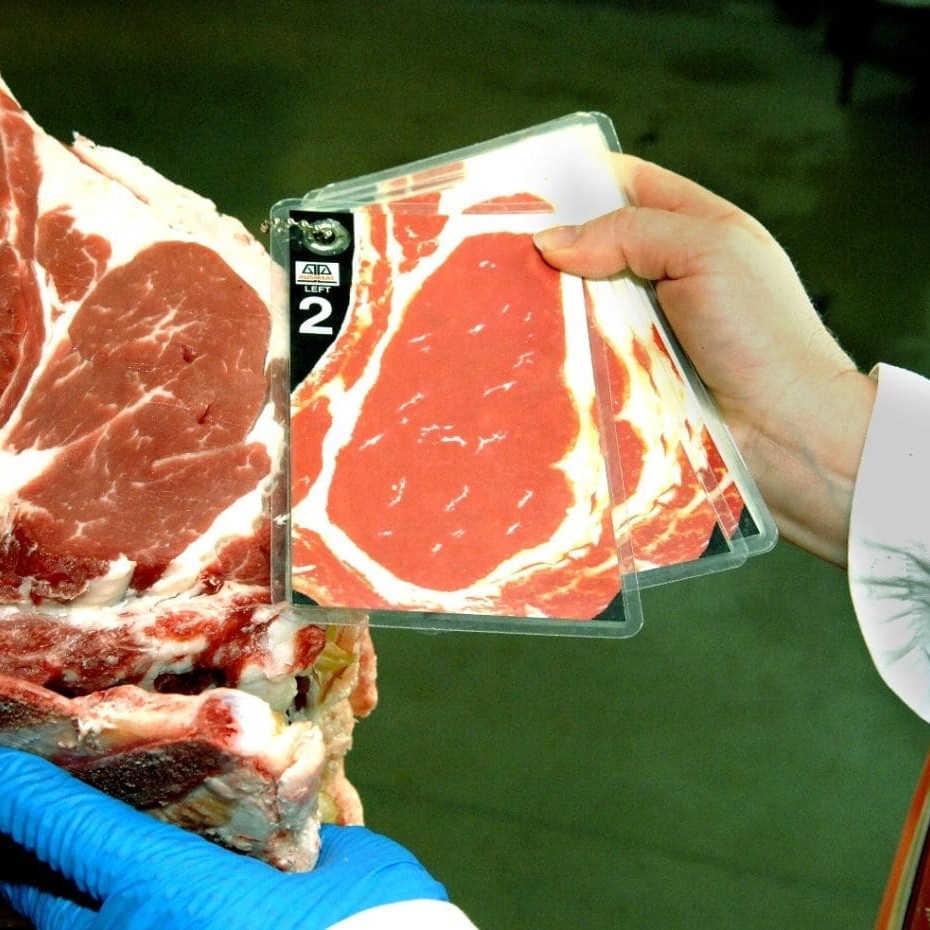 An important trend to emerge in grainfed slaughter cattle pricing in the past year has been the displacement of traditional 100-day grainfed cattle as the price-point around which other programs hinge, by MSA-eligible grainfed pricing.
An important trend to emerge in grainfed slaughter cattle pricing in the past year has been the displacement of traditional 100-day grainfed cattle as the price-point around which other programs hinge, by MSA-eligible grainfed pricing.
For most of the past year, for example, MSA grainfed pricing in many processor grainfed grids has been 5-10c/kg better than 100-day money.
A feature Beef Central noted during compilation of our most recent feedlot breakeven article is the current tendency for some cattle being fed for 100-day programs to be closed-out early, and divereted into MSA.
An example was seen in a line of 120 Darling Downs-bred Shorthorn x Angus steers currently in their final stages of a 100-day program at the Morgan family’s Lillyvale feedlot near Condamine. A wedge of them that best fitted specs were harvested early, a fortnight ago, for a Woolworths MSA contract after 75 days, instead of being fed-on for a further 30-40 days to export requirements.
The reason? Where once the 100-day grainfed price was the sweet-spot, with everything else falling into line around it, now MSA GFYG money is often better, and it can make financial sense to pull those cattle originally intended for 100-days for the MSA trades, where appropriate. The advantage applies particularly when cost of gain in the feedlot is high (currently 254c/kg, based on Beef Central’s regular 100-day feedlot breakeven.)
It also reflects the sheer momentum now being seen in the MSA marketplace. MSA grading numbers are currently up 16pc, year-to-date, and are forecast to reach 2.8 to 3 million head for the calendar year ending June 30 next year, up from 2.4 million last fiscal year.
On today’s market, there’s opportunity to get 365-370c for ‘non-grainfed’ MSA steer (where cattle are pulled out of the feedlot early before reaching the required 70 days on grain for a GF cipher); and 375c/kg if they complete their 70-days to get a GFYG cipher.
In comparison, 100-day spot cattle (non-MSA) are currently selling in a range from 370-385c/kg, depending on what the cattle are. Woolworths is currently paying 398c/kg to contract-holders for in-spec MSA 70-day steers, British-based, and 388c for MSA grainfed heifer.
All this suggests the shorter grainfed market is fundamentally changing: the ‘cherry on top’ is not necessarily after 100-days feeding any more – it can be found in MSA descriptions after shorter feeding periods.
This also has implications, of course, for feedlots in terms of annual throughout, especially during times of high occupancy like those being experienced this year. Feeding cattle for 60-70 days instead of 100 days for a better c/kg return offers potential for higher annual throughout and turnover.
All this presents as a huge shift in the grainfed industry dynamic, and one that bears watching, in Beef Central’s opinion. It is also a glowing endorsement for the impact that MSA is now having on the broader market.
A livestock manager with a large, multi-state processor told Beef Central that the biggest problem with spot 100-day grainfed cattle is that it is now a very limited audience to purchase them, because so many exporters now either feed their own, or have regular committed contract supply relationships to service regular export customers for 100-day beef.
“It means the vendor may at times either have a big win on 100-day cattle, or potentially, a big loss, because of that. If you have 100-day cattle these days, it’s not often that you can ring four buyers and have them fighting over them,” he said.
Recently one of the largest processors in Australia was offering just 365c/kg for 100-day cattle, perhaps 15-20c off the pace of the market, because they already had their positions covered for 100-day long-term meat contracts.
In that case, their pricing was not reflective of what 100-day cattle are currently worth, but simply throwing a price out into the market that said, “We don’t really need them to fill orders, but we’ll take them at a price.”
Wholesale market reflects pricing trend
There’s no shortage of evidence of the pricing distinctions in the domestic wholesale market, which during times like this can often attract large volumes of 100-day beef.
One of the nation’s largest wholesalers said the drought this year had made all MSA beef harder to procure.
“Particularly quality, lighter-weight MSA meat is going to be at a premium from here on in. Cattle that have done the time, and can be graded MSA, means it is now often more attractive to take them out after 60-70 days, instead of feeding on for another 30-40 days to heavier 100-day weights,” the wholesaler said.
“In years gone by, the c/kg price was about the same, or a bit less for MSA carcases, meaning the 100-day proposition was more attractive, because of the extra carcase weight involved. But with pricing as it now is with grainfed MSA at a premium over 100-day, more cattle are being pulled out earlier, because that weight component is being over-ridden by the MSA price advantage.”
Another point was that the best of the cattle gain performance has often been seen by day 70, with the final 30-40 days often delivering more moderate performance.
“MSA meat in lighter weight categories will be at a premium in coming months,” our wholesaler said late last week, “and that’s being reflected in these price premiums for MSA grainfed over 100-day.”
Coming into barbecue season, the wholesale market for MSA grainfed striploin last week was around $2/kg better than equivalent 100-day beef, which is harder to portion-cut into a desirable steak serve, because of its dimensions.
“That pricing depends on a few factors: who, how, and the weightrange of the meat,” Beef Central’s wholesaler contact said.
“Lighter weight ranges are the most desirable in MSA, because of that portion-size factor. In the domestic market, food service operators and retail customers don’t want that rib fillet that’s so big it falls off the edge of the plate, so it’s being driven by shortage.”
MSA cube-roll was the cut the domestic market would tend to hunt for at this time of the year, while tenderloins had a tendency to hit a price-point beyond which they get abandoned, in favour of other options.
“Tenderloins get whipped off the menu once they hit that trigger-point,” the wholesaler said.
Wholesale prices for good lighter MSA cube roll have recently been around $18-$20/kg, while typical 100-day cubes have sold recently at around $16/$17/kg.
Grading compliance holding up remarkably well
A number of large processors and supermarket retailers have commented on difficulty in getting grassfed cattle to grade for MSA over recent months.
“In the south, it’s being caused mostly by stressors associated with wild temperature variations in September and October. Cattle are struggling to cope with the change, and it’s being reflected in grading performance,” a processor said.
In Queensland, the grading problem was more due to the nutritional impact of drought on grassfed slaughter cattle being presented for grading.
“The glycogen bucket is very low in grassfed MSA cattle across Queensland, and it’s producing a lot more dark-cutters,” he said.
MLA’s Michelle Gorman said while MLA had heard similar anecdotal evidence from the market about impact on grading performance, MSA statistics, year-to-date, did not really reflect it.
“The interesting element is that the data in the north (i.e. Queensland) shows that there has been nil effect on grainfed, which is not surprising, but for those plants where we are able to isolate the grassfed MSA component, grading rates have only deteriorated by a couple of percent, year-to-date. That’s not that significant, when you consider the numbers involved, and the sort of season that has been experienced,” she said.
Nor has the overall numbers of grassfed cattle presented for MSA grading been impacted this year – in fact quite the reverse, grassfed grading numbers are up 72pc, for January-October year-to-date, MLA suggested.
“The message is that even though conditions are incredibly difficult, northern producers are doing an amazing job of increasing numbers graded, and maintaining the grading compliance against MSA specs, for the key areas where compliance can be an issue including dark cutting, pH and fat cover,” Ms Gorman said.
“Some individual Queensland plants will no doubt be facing challenges in MSA compliance, but the overall result is probably better than expected. Similarly in southern states, there has not been a significant shift in grading compliance this year.”
This finding underlined the importance of the glycogen story and optimum transport performance in extracting the best possible result out of MSA slaughter cattle during difficult times.
MLA was unable to provide monthly grading compliance data for September or October, to allow a comparison to be plotted against performance earlier in the year.

